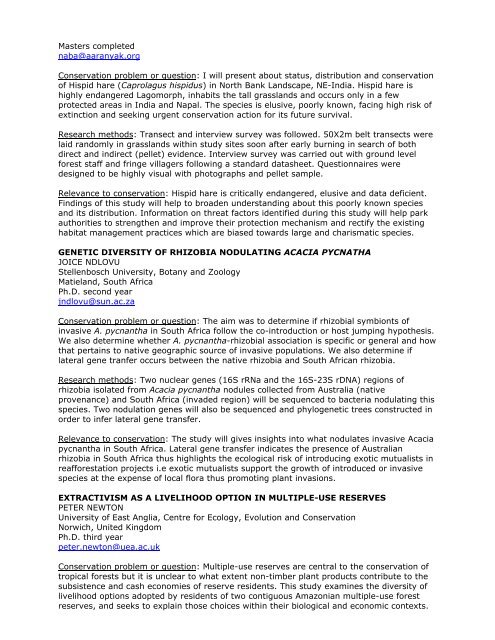Poster Abstracts in Word 29oct - American Museum of Natural History
Poster Abstracts in Word 29oct - American Museum of Natural History
Poster Abstracts in Word 29oct - American Museum of Natural History
Create successful ePaper yourself
Turn your PDF publications into a flip-book with our unique Google optimized e-Paper software.
Masters completednaba@aaranyak.orgConservation problem or question: I will present about status, distribution and conservation<strong>of</strong> Hispid hare (Caprolagus hispidus) <strong>in</strong> North Bank Landscape, NE-India. Hispid hare ishighly endangered Lagomorph, <strong>in</strong>habits the tall grasslands and occurs only <strong>in</strong> a fewprotected areas <strong>in</strong> India and Napal. The species is elusive, poorly known, fac<strong>in</strong>g high risk <strong>of</strong>ext<strong>in</strong>ction and seek<strong>in</strong>g urgent conservation action for its future survival.Research methods: Transect and <strong>in</strong>terview survey was followed. 50X2m belt transects werelaid randomly <strong>in</strong> grasslands with<strong>in</strong> study sites soon after early burn<strong>in</strong>g <strong>in</strong> search <strong>of</strong> bothdirect and <strong>in</strong>direct (pellet) evidence. Interview survey was carried out with ground levelforest staff and fr<strong>in</strong>ge villagers follow<strong>in</strong>g a standard datasheet. Questionnaires weredesigned to be highly visual with photographs and pellet sample.Relevance to conservation: Hispid hare is critically endangered, elusive and data deficient.F<strong>in</strong>d<strong>in</strong>gs <strong>of</strong> this study will help to broaden understand<strong>in</strong>g about this poorly known speciesand its distribution. Information on threat factors identified dur<strong>in</strong>g this study will help parkauthorities to strengthen and improve their protection mechanism and rectify the exist<strong>in</strong>ghabitat management practices which are biased towards large and charismatic species.GENETIC DIVERSITY OF RHIZOBIA NODULATING ACACIA PYCNATHAJOICE NDLOVUStellenbosch University, Botany and ZoologyMatieland, South AfricaPh.D. second yearjndlovu@sun.ac.zaConservation problem or question: The aim was to determ<strong>in</strong>e if rhizobial symbionts <strong>of</strong><strong>in</strong>vasive A. pycnantha <strong>in</strong> South Africa follow the co-<strong>in</strong>troduction or host jump<strong>in</strong>g hypothesis.We also determ<strong>in</strong>e whether A. pycnantha-rhizobial association is specific or general and howthat perta<strong>in</strong>s to native geographic source <strong>of</strong> <strong>in</strong>vasive populations. We also determ<strong>in</strong>e iflateral gene tranfer occurs between the native rhizobia and South African rhizobia.Research methods: Two nuclear genes (16S rRNa and the 16S-23S rDNA) regions <strong>of</strong>rhizobia isolated from Acacia pycnantha nodules collected from Australia (nativeprovenance) and South Africa (<strong>in</strong>vaded region) will be sequenced to bacteria nodulat<strong>in</strong>g thisspecies. Two nodulation genes will also be sequenced and phylogenetic trees constructed <strong>in</strong>order to <strong>in</strong>fer lateral gene transfer.Relevance to conservation: The study will gives <strong>in</strong>sights <strong>in</strong>to what nodulates <strong>in</strong>vasive Acaciapycnantha <strong>in</strong> South Africa. Lateral gene transfer <strong>in</strong>dicates the presence <strong>of</strong> Australianrhizobia <strong>in</strong> South Africa thus highlights the ecological risk <strong>of</strong> <strong>in</strong>troduc<strong>in</strong>g exotic mutualists <strong>in</strong>reafforestation projects i.e exotic mutualists support the growth <strong>of</strong> <strong>in</strong>troduced or <strong>in</strong>vasivespecies at the expense <strong>of</strong> local flora thus promot<strong>in</strong>g plant <strong>in</strong>vasions.EXTRACTIVISM AS A LIVELIHOOD OPTION IN MULTIPLE-USE RESERVESPETER NEWTONUniversity <strong>of</strong> East Anglia, Centre for Ecology, Evolution and ConservationNorwich, United K<strong>in</strong>gdomPh.D. third yearpeter.newton@uea.ac.ukConservation problem or question: Multiple-use reserves are central to the conservation <strong>of</strong>tropical forests but it is unclear to what extent non-timber plant products contribute to thesubsistence and cash economies <strong>of</strong> reserve residents. This study exam<strong>in</strong>es the diversity <strong>of</strong>livelihood options adopted by residents <strong>of</strong> two contiguous Amazonian multiple-use forestreserves, and seeks to expla<strong>in</strong> those choices with<strong>in</strong> their biological and economic contexts.
















